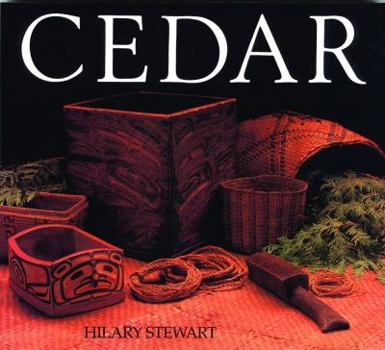Cedar
Select Format
Select Condition 
Book Overview
From the mighty cedar of the rainforest came a wealth of raw materials vital to the early Northwest Coast Indian way of life, its art and culture. For thousands of years these people developed the tools and technologies to fell the giant cedars that grew in profusion. They used the rot-resistant wood for graceful dugout canoes to travel the coastal waters, massive post-and-beam houses in which to live, steam bent boxes for storage, monumental carved poles to declare their lineage and dramatic dance masks to evoke the spirit world. Every part of the cedar had a use. The versatile inner bark they wove into intricately patterned mats and baskets, plied into rope and processed to make the soft, warm, yet water-repellent clothing so well suited to the raincoast. Tough but flexible withes made lashing and heavy-duty rope. The roots they wove into watertight baskets embellished with strong designs. For all these gifts, the Northwest Coast peoples held the cedar and its spirit in high regard, believing deeply in its healing and spiritual powers. Respectfully, they addressed the cedar as Long Life Maker, Life Giver and Healing Woman. Anecdotes, oral history and the accounts of early explorers, traders and missionaries highlight the text of Cedar . Hilary Stewart 's 550 drawings and a selection of 50 photographs depict how the people made and used the finished products of the incomparable tree of life to the Northwest Coast Indians -- the cedar.
Format:Paperback
Language:English
ISBN:1550544063
ISBN13:9781550544060
Release Date:March 1995
Publisher:University of Washington Press
Length:224 Pages
Weight:1.04 lbs.
Dimensions:9.0" x 0.5" x 10.0"
Customer Reviews
4 ratings
Cedar: Tree of Life to the Northwest Coast Indians
Published by Thriftbooks.com User , 15 years ago
Very well written. Extremely informative. A must for any one interesting in Northwest Coast Indian heritage
Compelling Look at a Tree and the Native People Who Relied on It
Published by Thriftbooks.com User , 16 years ago
Although this book is dedicated to the Cedar Tree, it is so much more than that. The author doesn't TELL you cedar is great, she SHOWS how amazing this tree is. The first chapter, "People of the Cedars," discusses these natives and how cedar was such an integral part of their lives and culture. The second chapter is a short look at the different cedars and how to identify each. The rest of the book is organized by the part of the tree being used (roots, wood, bark, etc.), and each section covers the various uses for that part of the tree (canoes, boxes, clothing, baskets, etc. etc. etc.). The author includes remarkably specific directions and drawings on how these things were made. For example, if you have basic woodworking skills, you should actually be able to make a bentwood box from her drawings and instructions. If you don't know woodworking, you will still find the drawings fascinating for the way they reveal how the item is made. Along with some nice black and white photos, the book is filled with hand drawings that are so clear and easy to understand that they should appear in textbooks on how to do illustrations. But the best aspect of this book is the way the author has managed to find that perfect balance of providing sufficient detail to tell you all of what you'd want to know, without sinking into boring academic prose or excruciating and unnecessary detail. Easy to read, well-written, and compelling content. The somewhat course, non-glossy, cream-colored pages pages are VERY easy on the eye, and the drawings are, in their own way, every bit as compelling as the glossy photos found in "coffee-table books." If you are interested in Northwest Coast Art or Culture, whether studying it or trying to create some of these things yourself, this is an absolute must-have book. Of the 160+ books on Northwest Coast art and culture in my personal library, this is one of my favorites. Buy it.
Interesting Look at Ancient Technology for Historians and Survivalists
Published by Thriftbooks.com User , 19 years ago
I've worked with cedar for several years, splitting posts and rails from culled old growth logs lying around on family forest land. I like working with cedar and this book looked like it might be interesting to read. It did not disappoint, but presented a fascinating description of how the natives used not only wood, but also bark, withes, and roots. The book is well organized and detailed descriptions of procedures and techniqures are augumented with many fine illustrations and photos. It is an enjoyable read for anyone interested in how to use cedar to provide clothing, shelter, tools, and furniture.
Cedar - Tree of Life is a labor of love & beauty!
Published by Thriftbooks.com User , 25 years ago
The Northwest Coastal people held the cedar & its spirit in high regard for all the gifts of life it offered them. For millennia they developed tools & skills to fell the giant trees to make canoes, post- & -beam homes, waterproof boxes & carved poles. Dedicated to those who know & respect the spirit of the Cedar, Hilary Stewart's book is a labor of love, respect & infinite knowledge. It intrigued her that people lived so well & for so long using almost exclusively the materials of their environment & her curiosity has wrought a fine book of early illustrations. A must for anyone interested in how the First People lived.






